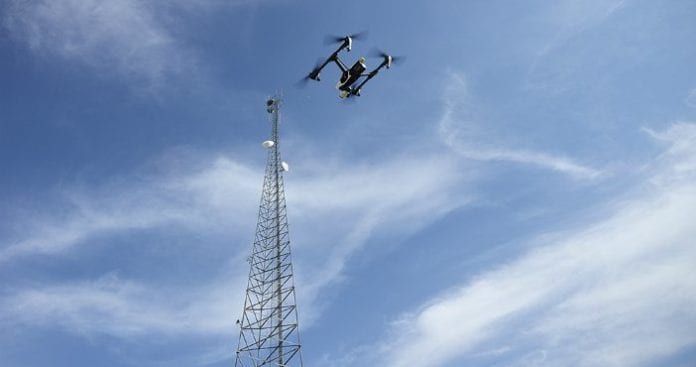Tower companies and carriers are using unmanned aerial vehicles, better known as drones, to photograph cell towers and even to transport equipment to the tower tops. The next step will come when drones actually carry robots that can install antennas and remote radio heads.
Drone operator ETAK Systems is already delivering equipment to the tower tops for its customers. Lee Priest, CEO of ETAK, said his competitors in the drone industry also are starting to use robotic systems. He said he expects drones will eventually replace tower climbers.
“We will take tower climbers off the towers. That’s our goal and we expect it to fully occur within five years,” said Priest. He said some of ETAK’s drones already have robotic arms that can touch the towers. “We are also looking at remote robots that can climb towers,” he said. “They can use the safety climb as well as the pegs to get up towers.”
The National Association of Tower Erectors recently established a committee to study unmanned aerial systems, and the committee’s first report looks at the use of drones to enhance both safety and productivity for tower climbers. But the association does not see drones replacing climbers.
“[Unmanned aircraft system] technology will never replace the workforce in our opinion, as they simply can’t perform the very technical work involved with rigging, changing lights, and antenna and line work, etc.,” said Todd Schlekeway, NATE ‘s executive director. “Any current operator who advocates that this technology can be a total replacement is misguided in my opinion.”
Schlekeway and the members of NATE’s UAS committee view drones as a way to help climbers work more efficiently and spend more time working on the ground rather than on the tower. Schlekeway said drones could be particularly valuable as the industry tackles the repacking of the 600 MHz spectrum that U.S. carriers are expected to acquire from broadcasters. This spectrum is deployed on towers that are typically much taller than cell towers.
“UAS use can assist with the scope of work including tower-site bid walks, tower-site hazard inspections, tower structural inspections, tower photo close out packages, etc.,” said Schlekeway. “Additionally, utilizing UAS in this manner will reduce the amount of times an elevated worker must ascend and descend a tower each day and therefore reduce the amount of repetitive climbing stress that is placed on the tower technician.”
Fewer climbs means the total cost of a project will be lower in most cases. ETAK’s Priest said his drones are able to cut the cost of a tower inspection in half.
“What you’re finding is the cost of using a drone vs. a third-party tower climber to verify an inspection is roughly about half to two-thirds,” said Priest. “And you can generally get a turnaround on that that’s several days faster.”
Priest hopes that many tower climbers will train to become drone operators. He said the Federal Aviation Administration no longer requires drone operators to hold a pilot’s license.
“It’s a much lower bar for someone to become certified,” he said, adding that tower climbers are uniquely qualified to operate drones on cell towers because they understand the work that needs to be done at the top.
For more on the use of drones in the tower industry, see our recent tower technology report and webinar.
Follow me on Twitter.

Could drones replace tower climbers?
ABOUT AUTHOR
